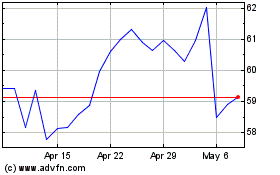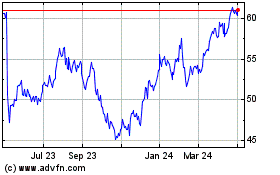Tyson Aided by Chicken, Prepared-Food Sales
November 23 2015 - 9:30AM
Dow Jones News
Tyson Foods Inc. posted better-than-expected revenue in its
latest quarter, helped by chicken and prepared-foods sales, though
revenue at its beef and pork segments recorded drops of 7.5% and
25%, respectively.
Adjusted profit came in below analysts' forecasts.
Looking ahead to next year, the company said it expects sales of
$41 billion in the 2016 fiscal year, above expectations of analysts
surveyed by Thomson Reuters who expect $40.4 billion.
Tyson and other beef processors have been buffeted by yearslong
contraction in the U.S. cattle herd due to drought in the southern
Plains. There had been hope that supply constraints seen in the
prior quarter would ease in the latest three-month period as
feedyards sold cattle that were kept on feed for longer
periods.
Overall, the company posted a profit of $258 million, or 63
cents a share, up from $137 million, or 35 cents a share, a year
earlier. Excluding certain items, earnings were 83 cents, down from
87 cents.
Revenue climbed 4% to $10.5 billion. Analysts surveyed by
Thomson Reuters forecast per-share earnings of 88 cents a share on
revenue of $10.3 billion.
In the chicken segment, adjusted feed costs decreased $130
million during the latest quarter. The segment registered a sales
volume climb on stronger demand, the company said.
Growth in the prepared food segment was driven by the
acquisition of Hillshire Brands, the maker of Jimmy Dean
sausage.
The beef segment produced a $70 million hit on profit in the
latest quarter related to mark-to-market open derivative positions
and lower-of-cost-or-market inventory adjustments as a result of a
sharp decline in live cattle futures during September.
During the quarter, the segment posted a $33 million operating
loss, down from a $153 million profit a year earlier.
The adjusted average price in the pork segment tumbled 23%. Live
hog supplies increased, which drove down livestock cost and
adjusted average sales price. U.S. hog herds rebounded faster than
expected this year from a virus that killed millions of pigs
beginning in the spring of 2013, resulting in a supply bulge.
Last week, Tyson announced plans to close two aging
prepared-food plants, in the face of prohibitive renovation costs
and changing demand. About 880 workers would be affected by the
closures of the plants in Jefferson, Wis., and Chicago.
In August, the company announced it was closing a 400-person
beef-processing plant in Iowa, citing declining U.S. cattle
herds.
The closures come as Tyson continues to remake itself after its
2014 acquisition of Hillshire Brands Co. Shortly after the
announcement of the acquisition, Tyson announced in July 2014 that
it was closing three prepared-food plants.
In recent quarters, revenue growth in the prepared-food division
has led the company's top-line growth, primarily as a result of the
Hillshire acquisition. In the latest quarter the prepared foods
division saw sales climb 60%.
Write to Ezequiel Minaya at ezequiel.minaya@wsj.com
Subscribe to WSJ: http://online.wsj.com?mod=djnwires
(END) Dow Jones Newswires
November 23, 2015 09:15 ET (14:15 GMT)
Copyright (c) 2015 Dow Jones & Company, Inc.
Tyson Foods (NYSE:TSN)
Historical Stock Chart
From Jun 2024 to Jul 2024

Tyson Foods (NYSE:TSN)
Historical Stock Chart
From Jul 2023 to Jul 2024
